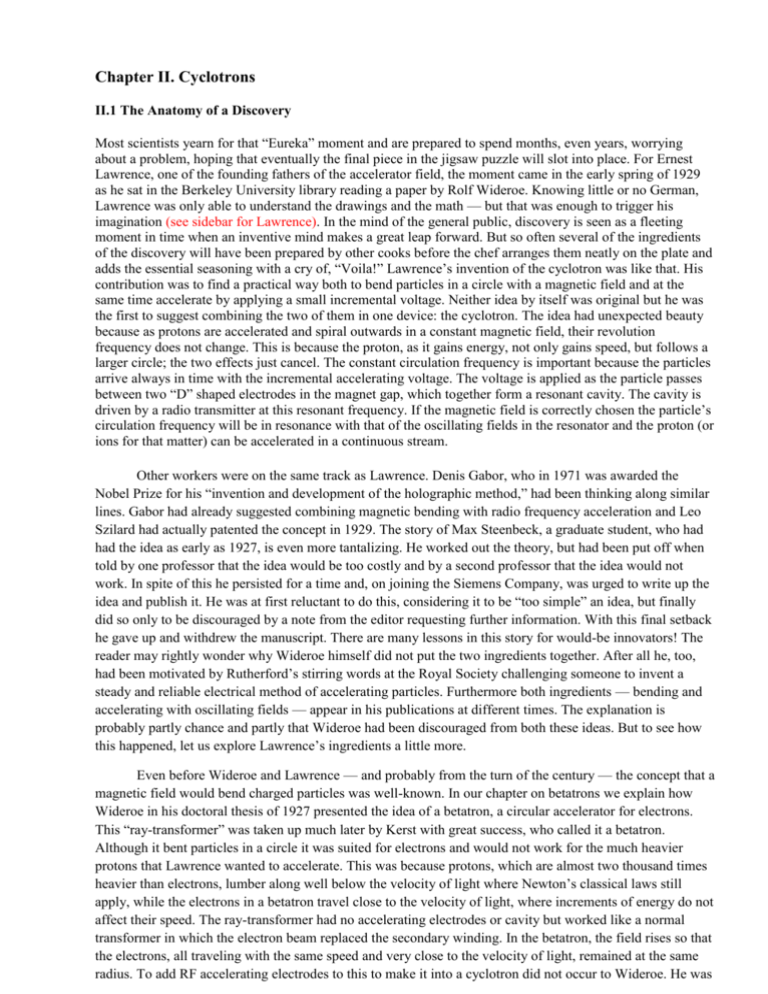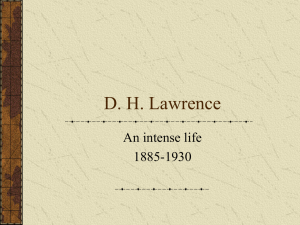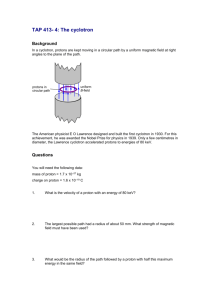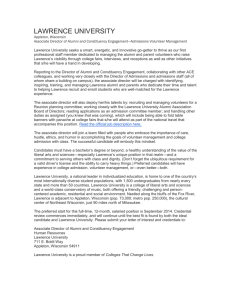Chap02(txt)120318 - John Adams Institute for Accelerator
advertisement

Chapter II. Cyclotrons II.1 The Anatomy of a Discovery Most scientists yearn for that “Eureka” moment and are prepared to spend months, even years, worrying about a problem, hoping that eventually the final piece in the jigsaw puzzle will slot into place. For Ernest Lawrence, one of the founding fathers of the accelerator field, the moment came in the early spring of 1929 as he sat in the Berkeley University library reading a paper by Rolf Wideroe. Knowing little or no German, Lawrence was only able to understand the drawings and the math — but that was enough to trigger his imagination (see sidebar for Lawrence). In the mind of the general public, discovery is seen as a fleeting moment in time when an inventive mind makes a great leap forward. But so often several of the ingredients of the discovery will have been prepared by other cooks before the chef arranges them neatly on the plate and adds the essential seasoning with a cry of, “Voila!” Lawrence’s invention of the cyclotron was like that. His contribution was to find a practical way both to bend particles in a circle with a magnetic field and at the same time accelerate by applying a small incremental voltage. Neither idea by itself was original but he was the first to suggest combining the two of them in one device: the cyclotron. The idea had unexpected beauty because as protons are accelerated and spiral outwards in a constant magnetic field, their revolution frequency does not change. This is because the proton, as it gains energy, not only gains speed, but follows a larger circle; the two effects just cancel. The constant circulation frequency is important because the particles arrive always in time with the incremental accelerating voltage. The voltage is applied as the particle passes between two “D” shaped electrodes in the magnet gap, which together form a resonant cavity. The cavity is driven by a radio transmitter at this resonant frequency. If the magnetic field is correctly chosen the particle’s circulation frequency will be in resonance with that of the oscillating fields in the resonator and the proton (or ions for that matter) can be accelerated in a continuous stream. Other workers were on the same track as Lawrence. Denis Gabor, who in 1971 was awarded the Nobel Prize for his “invention and development of the holographic method,” had been thinking along similar lines. Gabor had already suggested combining magnetic bending with radio frequency acceleration and Leo Szilard had actually patented the concept in 1929. The story of Max Steenbeck, a graduate student, who had had the idea as early as 1927, is even more tantalizing. He worked out the theory, but had been put off when told by one professor that the idea would be too costly and by a second professor that the idea would not work. In spite of this he persisted for a time and, on joining the Siemens Company, was urged to write up the idea and publish it. He was at first reluctant to do this, considering it to be “too simple” an idea, but finally did so only to be discouraged by a note from the editor requesting further information. With this final setback he gave up and withdrew the manuscript. There are many lessons in this story for would-be innovators! The reader may rightly wonder why Wideroe himself did not put the two ingredients together. After all he, too, had been motivated by Rutherford’s stirring words at the Royal Society challenging someone to invent a steady and reliable electrical method of accelerating particles. Furthermore both ingredients — bending and accelerating with oscillating fields — appear in his publications at different times. The explanation is probably partly chance and partly that Wideroe had been discouraged from both these ideas. But to see how this happened, let us explore Lawrence’s ingredients a little more. Even before Wideroe and Lawrence — and probably from the turn of the century — the concept that a magnetic field would bend charged particles was well-known. In our chapter on betatrons we explain how Wideroe in his doctoral thesis of 1927 presented the idea of a betatron, a circular accelerator for electrons. This “ray-transformer” was taken up much later by Kerst with great success, who called it a betatron. Although it bent particles in a circle it was suited for electrons and would not work for the much heavier protons that Lawrence wanted to accelerate. This was because protons, which are almost two thousand times heavier than electrons, lumber along well below the velocity of light where Newton’s classical laws still apply, while the electrons in a betatron travel close to the velocity of light, where increments of energy do not affect their speed. The ray-transformer had no accelerating electrodes or cavity but worked like a normal transformer in which the electron beam replaced the secondary winding. In the betatron, the field rises so that the electrons, all traveling with the same speed and very close to the velocity of light, remained at the same radius. To add RF accelerating electrodes to this to make it into a cyclotron did not occur to Wideroe. He was focused on accelerating electrons and it would not have worked for particles whose velocity was very much less than the velocity of light and varying as the particle gains energy. It was perhaps easier for Lawrence with no preconception to tie him down. Also, even though Wideroe’s theory of the electron motion turned out later to be sound, his thesis advisor in Karlsruhe, Wolfgang Gaede, had told him it would surely fail and he should find another topic for his research — circular machines were no longer on his agenda. The second idea occurs in Wideroe’s thesis (the paper Lawrence was mulling over in the library) where he described quite a different experiment: the first step to develop a linear accelerator for ions. This accelerator was based upon an earlier, theoretical, suggestion by Gustav Ising. The idea was to apply voltages oscillating at a radio frequency (RF) to a series of “cavities” or “drift tubes” in such a way that particles, passing through them like a string, threading a row of beads, would be given a little extra energy as they passed each gap between the tubes. We shall discuss this idea in some detail in Chapter III for it is the basis of a linear accelerator or “linac” (see Fig. 3.1). The length of the tubes was chosen so that as particles gained speed they would arrive at each gap just when the oscillating electric field between the tubes was pointed in the direction to accelerate them. Thus at no time was there any large voltage and, yet, the ions could be accelerated to high energy. (See Chapter III) In following this idea Wideroe was set on accelerating in a straight line and again to take the imaginative leap of Lawrence to see that the same accumulation of energy might be applied to a circular machine would have been too much to expect. A discovery is not always immediately put into practice. Archimedes’ cries of “Eureka” did not alert a crowd of plumbers eager to apply his discovery to the bathhouses of the ancient world. During the time before the inventor moves on to the next step and while still basking in his achievement, he will be very sensitive to any skeptical reception, as indeed we saw in the case of Wideroe. The next move must often await encouragement from a respected colleague. Although Lawrence had this idea in 1929, he didn’t work on it at first (he was busy with other things). He was eventually encouraged, in early 1930, to pursue the idea by Otto Stern — the same Otto Stern who was later, in 1943, to be awarded the Nobel Prize “for his contributions to the development of the molecular ray method and his discovery of the magnetic moment of the proton.” Lawrence had enough faith in Stern’s judgment to put a former graduate student, Niels Edlefsen, on to the problem, but there is doubt that Edlefsen ever achieved acceleration before he left in the summer of 1930. (See sidebar for Lawrence) Another general observation we might make while on the subject of inventors and their inventions is that the inventive mind wants often to move on to other things, and the hard grind of making an idea work is left to graduate students with an abundance of time and youthful enthusiasm at their disposal. Lawrence was no exception. In the autumn of 1930, he obtained two excellent graduate students: David Sloan and M. Stanley Livingston. Sloan was set to work mainly on Wideroe’s linear device and Livingston on the circular concept. By the end of 1930, Livingston had achieved resonance, and acceleration for 41 turns up to an energy of 80 kV in a 4-inch cyclotron. Livingston had to overcome many practical obstacles, including the development of a source of protons and obtaining a vacuum in the beam chamber between the magnet poles which was low enough for particles not to be scattered as they were accelerated (see Fig. 2.1). (See sidebar for Livingston) II.2 Lawrence and the Early Cyclotrons Encouraged by this first success, Lawrence set about building up a laboratory and a research team — perhaps the first on such a scale. To build accelerators, even these early cyclotrons, whose diameter is measured in inches rather than kilometers, required resources beyond those available in the normal university research departments of the 1930s. Lawrence started a process — unusual at the time but one with which modern physicists are only too familiar — of trawling for grants and support. Lawrence wanted these funds for bigger and bigger cyclotrons. In January of 1932, using a larger (11inch) cyclotron, Lawrence and Livingston, achieved 1.22 MeV. Soon there was a laboratory and a 27-inch cyclotron, a 37-inch cyclotron, a 60-inch cyclotron (see Fig. 2.2), and then plans for a 184-inch cyclotron. Raising money, especially during the Depression and long before the federal government was financing scientific research, was a very difficult job, which was allconsuming for Lawrence. He was very skilful and persistent in pursuing possible sources of funds, including the physics department officials of the University of California. They were most supportive, but at some stage the pressure was clearly wearing, to the point that the chairman of the physics department, Robert Birge, said, “Berkeley has become less a university with a cyclotron than a cyclotron with a university attached.” Meanwhile cyclotrons were being built in many other places and Lawrence was very generous in sharing the knowledge developed in his laboratory, setting a fashion of collaboration which has benefited the accelerator world ever since. By 1940 there were 22 cyclotrons under development or completed in the US alone. This reinforced the support for his own research. All this was helped along too by Lawrence’s own personality. Often discoveries are made by retiring and painstaking people and it is left to others to sing their praises but Lawrence was nothing if not an extrovert. He was ideally suited, not only to rouse support for bigger and better cyclotrons, laying the foundations of a Laboratory whose reputation is still the envy of the world; but also to inspire his co-workers to greater and greater achievement. Lawrence’s leadership, characterized by ever-bolder ideas, dominated his Laboratory. To achieve this he developed ever-growing competitive research teams each working even harder than the other. Managing the skills of others became for him a major activity — presaging today’s lab directors. This new way of doing science was, many think, Lawrence’s primary contribution to the field. (See the sidebar on the Lawrence Berkeley National Laboratory as well as Fig. 2.3.) A generation or more afterwards we come across those who were his students or taught by his students and who emulate his approach to science and to life Lawrence had a profound influence on the atmosphere at the Berkeley Radiation Laboratory. It had a spirit of dare-do, optimism and camaraderie that has been rarely matched by any other laboratory. Los Alamos during World War II inherited it, but this was no accident as J. Robert Oppenheimer, who led Los Alamos, had been Lawrence’s closest friend for the previous decade. Lawrence’s group enjoyed a commonality of purpose and sense of continued accomplishment that has rarely been duplicated elsewhere. Inevitably, there are many stories concerning the members of Lawrence’s laboratory. Jackson Laslett married Lawrence’s part-time secretary, Barbara Bridgeford. Glen Seaborg married Lawrence’s full-time secretary, Helen Griggs. Ed McMillan married Lawrence’s wife’s sister. Lawrence was a “hard driver.” On two separate occasions he fired Robert Wilson, who was later to become one of the giants of accelerator physics. The first time this happened was when Bob, then a graduate student, while tinkering with the cyclotron, broke a seal, which prevented the cyclotron from working on the following day when Lawrence wanted to demonstrate it to a prospective donor of funds. He was re-hired thanks to the intervention of Luis Alvarez. The second time was a bit later — this time for melting a pair of pliers while probing inside the cyclotron. When offered his job back, Wilson, who by now had his PhD, declined and went to Princeton. Nevertheless Bob Wilson had been profoundly influenced by Lawrence. Decades later McMillan’s wife, describing their similar personalities, told one of the authors, “you might never have had the pleasure to meet Lawrence but you can be sure that Bob Wilson was Ernest Lawrence ‘to a tee’.” On another occasion Lawrence saw someone with his feet up on the desk. He promptly went over and said, “You’re fired,” to which the victim replied, “You can’t fire me; I work for the phone company.” In spite of this rather summary approach to job appraisal there was tremendous loyalty amongst his staff and often genuine affection. Staff would meet every Monday evening at Lawrence’s home. These evenings were devoted to a seminar and discussion of some recent exciting physics — not necessarily related to cyclotrons or nuclear physics. This tradition was kept alive by Luis Alvarez decades later and he was always proud to comment that it was in the tradition of Lawrence — only the venue had changed. We have spent a long time describing the inventor of the cyclotron because his history is intimately bound up with that of his invention and hopefully illustrates all that it takes to invent. Having said so many flattering things about the father of the cyclotron, and the laboratory he founded, it is only fair to remind the reader, now studying the anatomy of discovery, that all great men and great labs make mistakes. Even Homer nods! Lawrence was not anyone who might be put off by doubts or criticism and if at times this led him to make mistakes, he took these in his stride. In fact, Lawrence and his cyclotron laboratory missed out on two great things and were wrong about another. They were not put off by this and, in the long run, went on to bring greater glory to their laboratory than those that “beat them out.” The first setback was that Lawrence et al. were beaten in the race to produce nuclear reactions by J.D. Cockcroft and E.T.S. Walton in 1932, which were recognized for this achievement by the Nobel Prize in physics (1951) “for their pioneering work on the transmutation of atomic nuclei by artificially accelerated atomic particles.” The second was something that with hindsight should not have been. In spite of Lawrence having the potential to produce induced radioactivity at Berkeley, this was discovered by Frederic Joliet and Irene Joliet-Curie, who received the Nobel Prize in chemistry (1935) for their “synthesis of new radioactive elements.” When he heard of this it only took Lawrence, and his people, half an hour to reproduce the JolietCurie result! They had been prevented from doing so by Lawrence’s passion for saving money. He had hooked the Geiger counters to the cyclotron power switch so that any induced activity remained unrecorded when the cyclotron was off. The other setback to his reputation came when Lawrence mistakenly proposed at a Solvay Conference in 1933, in which he was the only American, that the break-up of deuterium would be a power source. This statement brought upon him scathing comments from many of the great men of physics: Niels Bohr, Ernest Rutherford, Werner Heisenberg, and James Chadwick (all Nobel prize-winners) as well as other great physicists such as Otto Frisch. The reader may remember more recently that the proponents of “cold fusion” seemed to make the same mistake. Subsequent careful work disclosed that contaminated apparatus was the source of Lawrence’s error. It was left to Edwin McMillan, then a new member of Lawrence’s Laboratory, and who would later make important contributions to accelerator science, to restore Berkeley’s reputation. Ed was a very careful scientist. He extended the method used in the faulty work on deuterium to study heavier elements. He discovered the very important disintegration of deuterium (the nucleus of one proton and one neutron) — an effect that J. Robert Oppenheimer and his first student Melba Philips were the first to explain. And so, despite serious setbacks, which would have discouraged lesser men, Lawrence went on, learned from his mistakes, and saw his Laboratory accomplish great things. Laboratory participants eventually collected ten more Nobel prizes. The Laboratory played a key role, either in developing or greatly extending, linear accelerators, synchrotrons, heavy-ion accelerators, nuclear medicine, bubble chambers, computational analysis in high-energy physics and many other things. The Radiation Lab served as the model for almost all high-energy physics laboratories, such as the Brookhaven National Laboratory, Stanford Linear Accelerator Laboratory, and Fermilab, in the US. Both CERN, founded in 1954 by 20 European countries; and DESY, Germany’s national electron laboratory, used many aspects of the Berkeley model. And now is the time to see how the principles of more recent accelerators came to be discovered in the course of the development of the cyclotron. II.3 Transverse Focusing Particles have a long and high-speed journey to make as they are accelerated and they may well first start out in a direction that takes them well away from their acceleration orbit and head towards the upper or lower poles of the cyclotron magnet. They therefore have to be persuaded to return to the radius at which they will be accelerated and away from the top and bottom poles — a process called transverse focusing. Vital as this would appear to be, it was not even considered by Lawrence in his original proposal or in the first work with Stan Livingston. They were lucky that the gap between the poles was quite large and that in spite of losses, enough beam was accelerated to make their cyclotrons a success. The need to understand the focusing only came as they aimed to reduce the amount of beam lost. In fact, it was Stan who stumbled upon the subject, by accident, but then quickly realized what was going on. This transverse focusing and its counterpart in the direction of acceleration have become extremely important as accelerators have become larger in radius and their magnets have become smaller in cross section to economize the cost of the ring. Many workers devote their whole lives to aspects of focusing and we shall therefore return to it at greater length in other chapters. There are two basic kinds of focusing depending on the fields: electrostatic and magnetic. Both were discovered, in the course of looking for other things, by Stan Livingston. In the earliest cyclotrons the open ends of the “Dees,” which were like a cake tin cut across its diameter, were closed by a grid of wires. This was put in at the risk of scattering particles out of the beam, in the belief that it would produce a much more even accelerating field in the gap between the two halves of the tin and keep the beam in resonance. In the summer of 1931, while Lawrence was away, Livingston decided to see what would happen if he removed the grids. To his surprise, the resonance was still there and the intensity increased by a factor of 100. The reason, unanticipated but quickly appreciated, was that the curved field lines of the electric field spilled out from the open ends of the dees when the grids were removed. This provided vertical focusing and prevented the particles from flying off to the top and the bottom of the accelerating tank. This electrostatic focusing proved to be particularly effective at low energies near the center region of the cyclotron. Magnetic focusing was also discovered in the fall of that year, as Livingston mounted magnetic shims, thin iron disc-shaped plates inserted between the main magnet and the vacuum chamber. His aim was to smooth out the magnetic field; but he discovered that he obtained the most intense beam when the field was not constant, but when these shims were shaped so as to give the strongest field in the center of the cyclotron and a slightly (only slightly) lower field at the outside. It was immediately clear that the bent magnetic field lines, like those of the electrostatic field were focusing the accelerated particles into the median plane. This magnetic focusing was most effective at high energy and provided the perfect complement to electrostatic focusing. We will return to the subject of transverse focusing in Chapter IV. It is of vital importance for the design of these machines; Donald Kerst and Robert Serber, when building betatrons in 1941, first analyzed the effect quantitatively. A complete analysis of transverse focusing came in 1952 after another coincidental discovery, in which Livingston again played a major role. II.4 Relativistic Limitation By 1937 Lawrence, who by then had built a number of large cyclotrons of increasing size, set his sights on building one that would deliver 100 MeV protons. Hans Bethe and his student Morris Rose thought this was not possible. They wrote a paper in which they concluded that as protons began to feel the effect of relativity, the increase of their apparent mass would destroy the cyclotron resonance condition and make it impossible to go much beyond the 37-inch machine. The opinion of Bethe could not be lightly dismissed. He led the theoretical section under J. Robert Oppenheimer at Los Alamos and later won the Nobel Prize for his explanation of how the sun gave out solar energy in prodigious amounts. However, Lawrence responded to Bethe with the remark “We have learned from repeated experience that there are many ways of skinning a cat.” The more circumspect Edwin McMillan did more careful theoretical work and convinced Bethe that protons might nevertheless be accelerated to at least 20 MeV and possibly 30 MeV. Lawrence always argued that money, not relativity, was the primary problem. In November 1939 he was awarded a Nobel Prize and the fame greatly boosted his ability to raise money — and with it his ambition. Deuterons with twice the mass of the proton would be less prone to relativistic effects and would stand a chance of reaching his goal of 100 MeV. The cyclotron to achieve this would have a diameter of 184 inches (it would have been larger, but that was the largest size of commercially available steel plate); see Fig. 2.4. Just how it was to reach such energy was never made clear, but such energy would allow the artificial production of the new meson that had just been observed in cosmic rays. The cyclotron was soon started and commissioning took place in the summer of 1941. About this time a solution to the relativistic energy limit did in fact emerge, thanks to a method of transverse focusing proposed by L.H. Thomas. (See sidebar for Thomas) This involved dividing the poles of a cyclotron into a number of segments (like an orange) and shaping their boundaries to restore particles which swung away from a circular orbit. The theory was difficult to understand and it was only much later, after World War II, and after some other less elegant solutions had been tried, that it was applied. Thomas focusing was studied at Berkeley by Oppenheimer’s student, Leonard Schiff, who later made many important contributions to relativity, did some extensive calculations concluding that implementation of Thomas’ ideas was not easy. It was just too much ahead of its time. II.5 Phase focusing and the Synchrocyclotron The World War affected Lawrence’s laboratory considerably. His largest, 184-inch, cyclotron had been diverted from its original purpose until after the war and cyclotron development had ground to a halt as Lawrence’s team was dispersed. He himself, becoming increasingly frustrated, adapted the cyclotron idea to build Calutrons for the separation of U-235 for the production of Atomic Bombs. (see Chapter XIV). However preoccupied they may be with other more pressing business, there is usually a small region in the back of a scientist’s mind that always works away subconsciously — on the lookout for another “Eureka.” In 1945, Ed McMillan, who was still at Los Alamos, suddenly realized an ingenious way to allow cyclotrons to overcome the relativistic limitation and accelerate to much higher energies. His idea was to interrupt the steady stream of particles accelerated in the cyclotron, and send pulses, or bunches, of particles on their journey from the centre of the machine to the rim of the magnet. By tuning the frequency of the radio energy source one might hope to keep in resonance as the revolution frequency of the particles sagged due to their relativistic increase in mass. The final piece of the jigsaw was to keep the particles in synchronism with the RF by “phase focusing.” By accelerating the ideal particle on the falling edge of the RF sine wave, particles which lag behind get more energy and catch up with their brothers while those that are too far ahead see a smaller accelerating voltage. The same idea was hit upon, independently by V. Veksler. (See sidebars for McMillan and Veksler) In fact phase focusing is at the heart of the synchrotron (see Chapter V), a machine which was invented about this time and, once demonstrated on a “synchrotron model,” was soon to be incorporated into the 184inch cyclotron. II.6 FFAG We will read in Chapter V that the discovery of the synchrotron in the closing days of the war dominated the construction of new proton machines in the decade that followed — but it was not to the complete exclusion of cyclotrons. With the discovery in the early 50s by Courant, Livingston and Snyder of alternate gradient focusing (described in Chapter V) all sorts of new focusing schemes became possible. This was just at that time that the Midwestern Universities Research Association (MURA) was formed to urge the Atomic Energy Commission (AEC) to build an accelerator in the Midwest. Up until that time only the west and east coasts boasted accelerators. The MURA Group was led by Donald Kerst of betatron fame, and made many innovative contributions to the physics of beams, but sadly they were never able to obtain AEC support for construction of a large accelerator. In due course, MURA re-emerged as the Physical Sciences Laboratory at Wisconsin and became one of the early players in developing synchrotron radiation science. However, in a certain sense the goal of MURA was achieved, for an accelerator, the Zero-Gradient Synchrotron (ZGS), was built at the Argonne National Laboratory. (See sidebar on MURA) Keith Symon, then a member of MURA, realized that an accelerator could be constructed with a magnetic field which, like that of a cyclotron, and in contrast with that of a synchrotron, was constant in time. The field might be shaped to accommodate a wide range of energies from injection to top energy within a relatively small band of radii — its magnet aperture rather like the brim of a sombrero. The beam would be accelerated in a series of bursts relying upon McMillan’s phase focusing but it would not be necessary to pulse the magnet. These accelerators were called “fixed-field alternate gradient” (FFAG for short); see Fig. 2.5 There were a number of ways to accomplish this, all of which differed according to the pattern of the magnetic field around the circumference, and MURA constructed models of both a “radial sector” and a “spiral sector” type. The spiral sector was more complicated, but more efficient in its use of magnetic field; see Fig. 2.6. (See sidebar for Symon) The reader will remember that Llewellyn Thomas had earlier also developed an azimuthally varying magnetic field that allowed cyclotrons to go beyond the relativistic limit even when run for a continuous beam. His work came long before the concept of alternating gradient focusing, but the importance of his work was unappreciated and even unknown to essentially everyone involved in accelerator design. His “Eureka” had fallen on deaf ears, which was a pity because it had offered a path back to the continuous beam machine. The MURA Group was to follow the same path. At about the same time as Symon’s innovative work, a similar idea was put forward by a young Japanese, Tihiro Ohkawa. The MURA Group learned of Ohkawa’s work and invited him to join the effort, which he did (see sidebars for Thomas, Symon, and Ohkawa). Independently, A.A. Kolomenski, in the Soviet Union, also invented the idea of FFAG. (See sidebar for Ohkawa) The MURA Group became somewhat obsessed with the FFAG concept and proposed a number of large accelerators in the range of 10 GeV based on this principle. Their virtue was their high intensity. None of these devices were ever realized. II.7 Spiral Sector Cyclotrons The work on FFAG, at MURA, aimed to provide an alternative to the synchrotron for high-energy physics and they were thought to be particularly appropriate for colliding beam devices. However, it became clear, even at an early stage, that the spiral sector concept would also make a very good cyclotron. In particular, the varying field allowed separated sectors which could be relatively easily manufactured and assembled. Most importantly, in contrast to the pulsed phase focused cyclotrons, the beam remained much closer to resonance and the radio frequency changes were much smaller. Soon, a number of spiral sector cyclotrons were under study and construction, notably at Oak Ridge (USA), Chalk River (Canada) and Rutherford Laboratory (England). Later the first superconducting cyclotron was built at Michigan State by Henry Blosser, who was associated with MURA while he was a student. II.8 Modern Cyclotrons Ordinary cyclotrons are used mainly for dating purposes (as discussed below), and isotope production. However spiral sector cyclotrons are important, even to this day, in nuclear physics. Three very large and very productive machines are the 88-inch cyclotron at Lawrence’s Berkeley Laboratory, the 520 MeV cyclotron at TRIUMF (Fig. 2.7), and the 590 MeV cyclotron at the Paul Scherrer Institute, Switzerland; these are also major cyclotron labs at IUCF and RIKEN and, in fact, the world’s largest cyclotron is at RIKEN (See Fig.9.10) In recent years a few 200 MeV proton machines have also been built for cancer therapy. These are to be found in Part B in Chapter XI, while some other modern applications of cyclotrons are discussed in Chapter XV.






